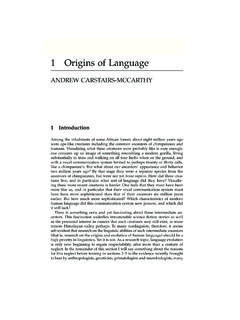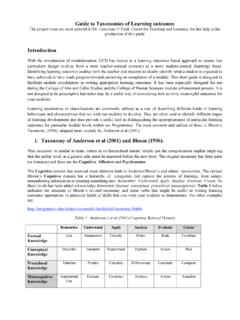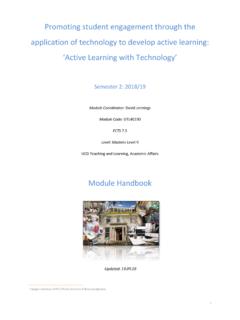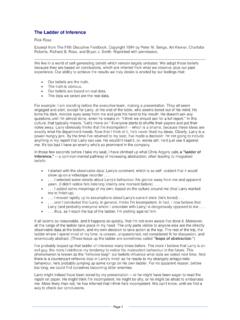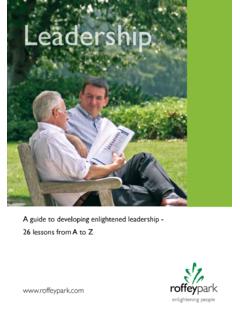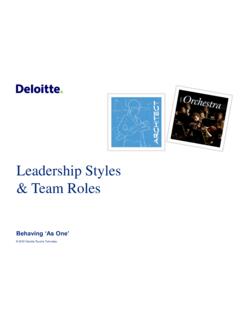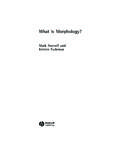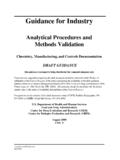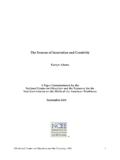Transcription of Analytical Driver Red Blue - University College Dublin
1 1 Study based on the researchs of Merrill & Roger, Personal Styles and Effective Performance - 1981 & Bolton&Bolton s Social Style and Management - 1984 This document is prepared by Timur Tiryaki Basari Akademisi Timur Tiryaki Success Academy presents Personality Categories (Social Behavior Types) based on Merrill-Reid Styles (For more information and assessment methods please contact ) Overview of Model The method used by most management training workshops and employers is the ever-popular Merrill-Reid method, which categorizes personality types into 4 as: Driver Expressive Amiable Analytical These styles are defined by two behavioral variables or dimensions: assertiveness and responsiveness. Analytical blue Driver Red Amiable Green Expressionist Yellow 2 Study based on the researchs of Merrill & Roger, Personal Styles and Effective Performance - 1981 & Bolton&Bolton s Social Style and Management - 1984 This document is prepared by Timur Tiryaki Basari Akademisi Assertiveness = the degree to which a person's behaviors are seen by others as forceful or directive.
2 Responsiveness= the degree to which a person's behaviors are seen by others as emotionally controlled. More responsive people react noticeably to their own emotions or to the emotions of others. Less responsive people are more guarded in their emotional expression. While no one style works better than any other, flexibility has been shown to distinguish the success manager of conflict from the unsuccessful. Flexibility=the ability to get along with people whose styles differ from one's own. Comparison with Other Methods: 2 of the 3 Jung Typologies are same with this method, Extroversion-Introversion (E-I) and Thinking-Feeling (T-F) vectors. Jung Typology Tests differ in one vector (Sensing-Intuition, S-N) and Myers Briggs differs with another vector Judging-Perceiving (J-P). ---------------------------------------- -------------- Studies from Jung Typologies: Extroversion-Introversion (E-I) Extroversion-Introversion (E-I) is the most important scale.
3 The developers of Jung personality test have calculated that about one third of the population is extroverted. You may be extrovert when you concentrate on people and the environment around you. However, you are considered introvert when you focus on your thoughts and ideas. Sensing-Intuiting (S-N) Sensing Intuiting (S-N) is the next scale denoted. In it about 75 % of the population belongs to sensing. Thinking-Feeling (T-F) Thinking - Feeling is the third scale represented by (T-F). These are dispersed evenly through the population, as two-thirds of men are thinkers, while two-thirds of women are feelers. ---------------------------------------- ---------- DISC test uses the same vectors and is very close to this approach. It only differs by creating a sub-category. The 4 personality types approach creates a foundation for further self analysis and provides the basic framework for understanding one s self. 3 Study based on the researchs of Merrill & Roger, Personal Styles and Effective Performance - 1981 & Bolton&Bolton s Social Style and Management - 1984 This document is prepared by Timur Tiryaki Basari Akademisi Characteristics of 4 Personality Categories Driver : o Objective-focused o Know what they want and how to get there!
4 O Communicates quickly, gets to the point o Sometimes tactless and brusque o Can be an "ends justify the means" type of person o Hardworking, high energy ?Does not shy away from conflict Expressive: o Natural salesmen or story-tellers o Warm and enthusiastic o Good motivators, communicators o Can be competitive o Can tend to exaggerate, leave out facts and details o Sometimes would rather talk about things than do them! Amiable: o Kind-hearted people who avoid conflict o Can blend into any situation well o Can appear wishy-washy Has difficulty with firm decisions o Often loves art, music and poetry Highly sensitive o Can be quiet and soft-spoken Analytical : o Highly detail oriented people o Can have a difficult time making decisions without ALL the facts o Make great accounts and engineers o Tend to be highly critical people o Can tend to be pessimistic in nature o Very perceptive 4 Study based on the researchs of Merrill & Roger, Personal Styles and Effective Performance - 1981 & Bolton&Bolton s Social Style and Management - 1984 This document is prepared by Timur Tiryaki Basari Akademisi Table of Equivalents for the 4 Types in Various Personality Tests Table of Equivalents for the 4 Personality Types Merrill-Reid Driver Expressive Amiable Analytical Dominant Expressive Solid Analytical Hippocrates Greek Terms (370 BC) Choleric Sanguine Phlegmatic Melancholy Western Astrology Fire Air Water Earth "What's My Style?
5 " (WMS) Direct Spirited Considerate Systematic The P's Powerful Popular Peaceful Perfect The S's Self-propelled Spirited Solid Systematic The A's Administrative Active Amiable Analytical LEAD Test Leader Expressor Dependable Analyst ARRAY (Jonathan Knaupp) Production Connection Status Quo Harmony Biblical Characters Paul Peter Abraham Moses Geier Dominance Influencing Competence Steadiness DiSC(r) Dominance Influencing of Others Steadiness Cautiousness/ Compliance 5 Study based on the researchs of Merrill & Roger, Personal Styles and Effective Performance - 1981 & Bolton&Bolton s Social Style and Management - 1984 This document is prepared by Timur Tiryaki Basari Akademisi McCarthy/4 MAT System Common Sense Dynamic Innovative Analytic Merrill / Wilson Driver Expressive Amiable Analytic Plato (340 BC) Guardian Artisan Philosopher Scientist Kretschner (1920) Melancholic Hypomanic Anesthetic Hyperasthetic Sprangler (1930) Religious Aesthetic Theoretic Economic From (1947) Hoarding Exploiting Receptive Marketing Psycho-Geometrics (1978) Triangle Squiggle Circle Square/Rectangle Type A or B Type B Motivated Type B Messy Type A Casual Type A Compulsive PSI Controller Promoter Supporter Analyst Brokenleg Reclaiming Youth at Risk Mastery Achiever Power Belonging Attached Significance Generosity Altruistic Virtue Independence Autonomous Competence Enneagram Adventurer Achiever Helper Romantic Peacemaker Observer Asserter Perfectionist Animals Bear Monkey Dolphin Owl True Colors(r) (1978) Green Orange blue Gold Children's Literature Rabbit Tigger Pooh Eeyore Charlie Brown Characters Lucy Snoopy Charlie Brown Linus Jane Austen Novel Characters Emma Woodhouse Lydia Bennet Elizabeth Bennet Marianne Dashwood Comics Jason Snoopy Cathy Ziggy Who Moved My Cheese?
6 (by Spencer Johnson, ) Sniff Scurry Haw Hem The Celestine Prophecy (by James Redfield) Intimidator Poor Me Aloof Interrogator 6 Study based on the researchs of Merrill & Roger, Personal Styles and Effective Performance - 1981 & Bolton&Bolton s Social Style and Management - 1984 This document is prepared by Timur Tiryaki Basari Akademisi APPLICATIONS by The Key Ba ar Akademisi LTD ( ) Step 1: Self-Evaluation - With a 15 minute survey (15 questions) we can map the self-perception of a person and categorize primary strengths and weaknesses. Step 2: Cross Check Self Evaluation - With additional cross-checking test (word selections) we can test the self perception and reliability of the self-evaluation. Step 3: 360 Tests for Comparisons - With 360 tests we can test self-awareness (are you aware how others perceive you?) and determine your gaps between self-perception and actual behaviors. Step 4: One-on-one coaching sessions Personal Strategic Planning.
7 Indentifying personal mission statement, vision, goals, values, strengths, talents, passions, role models through one-on-one discussions. Example one page summary of an analysis: 7 Study based on the researchs of Merrill & Roger, Personal Styles and Effective Performance - 1981 & Bolton&Bolton s Social Style and Management - 1984 This document is prepared by Timur Tiryaki Basari Akademisi MORE DETAILS ON THE 4 TYPES Type Strengths Potential Weaknesses Analytical Thinking Thorough Disciplined Excludes feelings from decisions Goes too far; perfectionist Too rigid or demanding of self/others Amiable Supportive Patient Diplomatic Tends to conform to wishes of others No time boundaries; things do not get done Not assertive or directive Driver Independent Decisive Determined Has trouble operating with others Does not take time to consider other perspectives Domineering; too focused on doing it "my way" Expressive Good communicator Enthusiastic Imaginitive Talks too much Comes on too strong Dreamer.
8 Unrealistic The Analytical The Analytical is polite but reserved, logical, fact- and task-oriented. This person s focus is on precision and perfection. Other strengths include persistence, diligence, caution, and a systematic approach. Weaknesses involve being withdrawn, boring, quiet, reclusive, and even sullen at times. If he or she seems indecisive, it s because of a need to assess all the data. Perfectionism can be a fault if the Analytical pushes it too far. This person is definitely not a risk-taker. The Analytical needs to be right, and won t openly discuss ideas until confident in a decision. His or her pleasure is accuracy. Pain is to be wrong and criticized. When communicating with an Analytical 8 Study based on the researchs of Merrill & Roger, Personal Styles and Effective Performance - 1981 & Bolton&Bolton s Social Style and Management - 1984 This document is prepared by Timur Tiryaki Basari Akademisi Be systematic, thorough, deliberate, and precise Focus on the task Be prepared to answer many how questions Provide analysis and facts Don t get too personal Recognize and acknowledge the need to be accurate and logical Don t rush unnecessarily Expect to repeat yourself Allow time for evaluation Use lots of evidence Compliment the precision and accuracy of the completed work.
9 Portrait of an Analytical s office The first thing you notice will probably be the glasses. The Analytical will have worn out his or her eyes from constantly reading everything. On the wall you may see a framed degree, but the chief decoration will be charts, figures, and graphs of every kind. The Analytical is not very friendly, will often greet you skeptically, and doesn t want to share much especially anything personal. There will be no flowers or plant; for the Analytical , they belong in greenhouses. On the desk will be only business-related information, and that will be carefully arranged. It s not a power office, but it definitely will be functional. As for color, black and white will do nicely. Symbol: Owl. The Amiable Devoted, consistent, dependable, and loyal, the Amiable is a hard worker and will persevere long after others have given up. He or she is a team player, cooperative and easy to get along with, trustful, sensitive and a good listener.
10 Working in groups with cooperative individuals, the Amiable tries to avoid confrontation. He or she enjoys company, performs best in a stable environment, and often has a stabilizing effect on others. Weaknesses include indecision and an inability to take risks. Amiables are often too focused on others, conforming, quiet, and passive. They often won t speak up for themselves, are too compliant and nice, and often painstakingly slow to make decisions. The Amiable s pleasure is stability and cooperation. His or her pain is change and chaos. When communication with an Amiable Be relaxed and agreeable Maintain the status quo 9 Study based on the researchs of Merrill & Roger, Personal Styles and Effective Performance - 1981 & Bolton&Bolton s Social Style and Management - 1984 This document is prepared by Timur Tiryaki Basari Akademisi Be logical and systematic Create a plan with written guidelines Be prepared to answer why questions Be predictable Agree clearly and often Use the word we Don t push Don t rush Compliment him or her as a team player Be a good listener Portrait of an Amiable s office The first thing you will notice will be pictures of loved ones on the desk: husband, wife, family, favorite pets.
